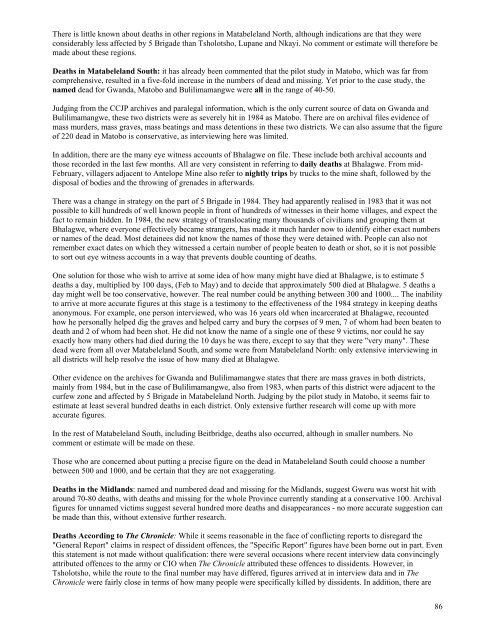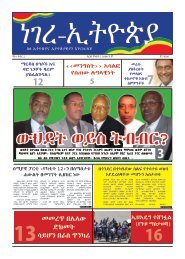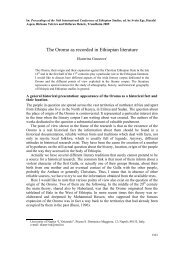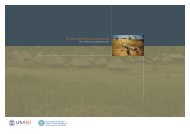MatabelelandReport
MatabelelandReport
MatabelelandReport
You also want an ePaper? Increase the reach of your titles
YUMPU automatically turns print PDFs into web optimized ePapers that Google loves.
There is little known about deaths in other regions in Matabeleland North, although indications are that they were<br />
considerably less affected by 5 Brigade than Tsholotsho, Lupane and Nkayi. No comment or estimate will therefore be<br />
made about these regions.<br />
Deaths in Matabeleland South: it has already been commented that the pilot study in Matobo, which was far from<br />
comprehensive, resulted in a five-fold increase in the numbers of dead and missing. Yet prior to the case study, the<br />
named dead for Gwanda, Matobo and Bulilimamangwe were all in the range of 40-50.<br />
Judging from the CCJP archives and paralegal information, which is the only current source of data on Gwanda and<br />
Bulilimamangwe, these two districts were as severely hit in 1984 as Matobo. There are on archival files evidence of<br />
mass murders, mass graves, mass beatings and mass detentions in these two districts. We can also assume that the figure<br />
of 220 dead in Matobo is conservative, as interviewing here was limited.<br />
In addition, there are the many eye witness accounts of Bhalagwe on file. These include both archival accounts and<br />
those recorded in the last few months. All are very consistent in referring to daily deaths at Bhalagwe. From mid-<br />
February, villagers adjacent to Antelope Mine also refer to nightly trips by trucks to the mine shaft, followed by the<br />
disposal of bodies and the throwing of grenades in afterwards.<br />
There was a change in strategy on the part of 5 Brigade in 1984. They had apparently realised in 1983 that it was not<br />
possible to kill hundreds of well known people in front of hundreds of witnesses in their home villages, and expect the<br />
fact to remain hidden. In 1984, the new strategy of translocating many thousands of civilians and grouping them at<br />
Bhalagwe, where everyone effectively became strangers, has made it much harder now to identify either exact numbers<br />
or names of the dead. Most detainees did not know the names of those they were detained with. People can also not<br />
remember exact dates on which they witnessed a certain number of people beaten to death or shot, so it is not possible<br />
to sort out eye witness accounts in a way that prevents double counting of deaths.<br />
One solution for those who wish to arrive at some idea of how many might have died at Bhalagwe, is to estimate 5<br />
deaths a day, multiplied by 100 days, (Feb to May) and to decide that approximately 500 died at Bhalagwe. 5 deaths a<br />
day might well be too conservative, however. The real number could be anything between 300 and 1000.... The inability<br />
to arrive at more accurate figures at this stage is a testimony to the effectiveness of the 1984 strategy in keeping deaths<br />
anonymous. For example, one person interviewed, who was 16 years old when incarcerated at Bhalagwe, recounted<br />
how he personally helped dig the graves and helped carry and bury the corpses of 9 men, 7 of whom had been beaten to<br />
death and 2 of whom had been shot. He did not know the name of a single one of these 9 victims, nor could he say<br />
exactly how many others had died during the 10 days he was there, except to say that they were "very many". These<br />
dead were from all over Matabeleland South, and some were from Matabeleland North: only extensive interviewing in<br />
all districts will help resolve the issue of how many died at Bhalagwe.<br />
Other evidence on the archives for Gwanda and Bulilimamangwe states that there are mass graves in both districts,<br />
mainly from 1984, but in the case of Bulilimamangwe, also from 1983, when parts of this district were adjacent to the<br />
curfew zone and affected by 5 Brigade in Matabeleland North. Judging by the pilot study in Matobo, it seems fair to<br />
estimate at least several hundred deaths in each district. Only extensive further research will come up with more<br />
accurate figures.<br />
In the rest of Matabeleland South, including Beitbridge, deaths also occurred, although in smaller numbers. No<br />
comment or estimate will be made on these.<br />
Those who are concerned about putting a precise figure on the dead in Matabeleland South could choose a number<br />
between 500 and 1000, and be certain that they are not exaggerating.<br />
Deaths in the Midlands: named and numbered dead and missing for the Midlands, suggest Gweru was worst hit with<br />
around 70-80 deaths, with deaths and missing for the whole Province currently standing at a conservative 100. Archival<br />
figures for unnamed victims suggest several hundred more deaths and disappearances - no more accurate suggestion can<br />
be made than this, without extensive further research.<br />
Deaths According to The Chronicle: While it seems reasonable in the face of conflicting reports to disregard the<br />
"General Report" claims in respect of dissident offences, the "Specific Report" figures have been borne out in part. Even<br />
this statement is not made without qualification: there were several occasions where recent interview data convincingly<br />
attributed offences to the army or CIO when The Chronicle attributed these offences to dissidents. However, in<br />
Tsholotsho, while the route to the final number may have differed, figures arrived at in interview data and in The<br />
Chronicle were fairly close in terms of how many people were specifically killed by dissidents. In addition, there are<br />
86







